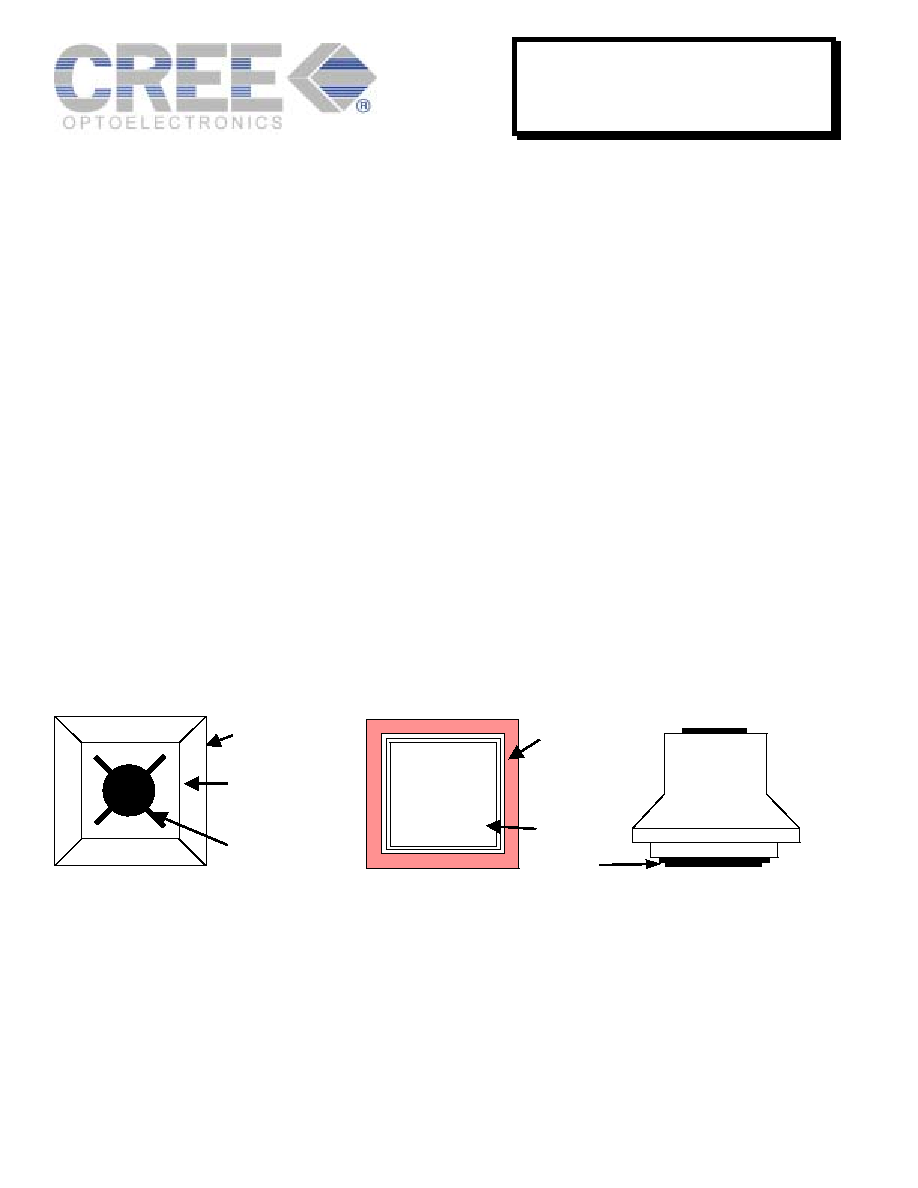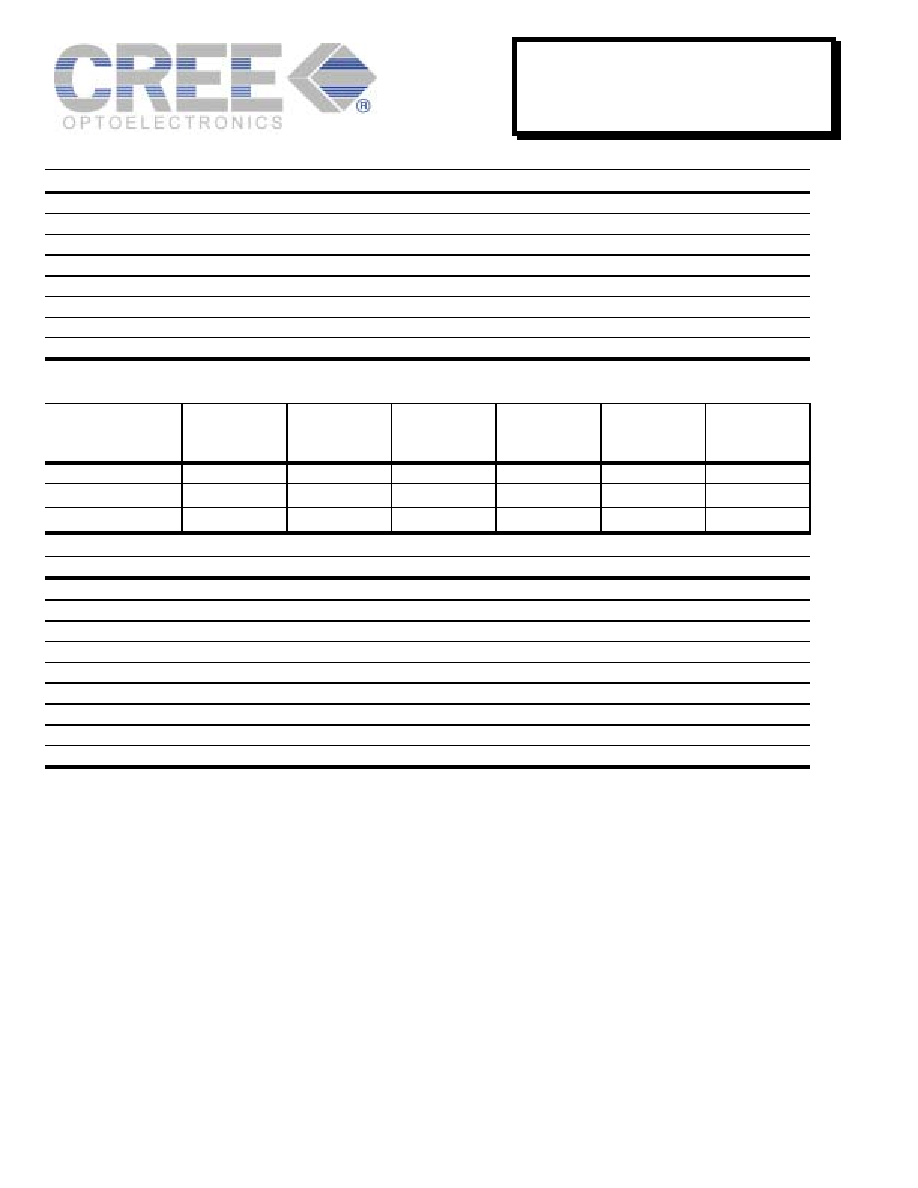
G
∑
SiC
Æ
Technology
XBright
Æ
Plus
LEDs
Cxxx-XB290-S0100-A-Plus
Features Applications
∑ XBright
Æ
Plus
Performance
≠ 15.0 mW min Blue
∑ Single Wire Bond Structure
∑ Class II ESD Rating
∑ Outdoor LED Video Displays
∑ Automotive Dashboard Lighting
∑ White LEDs
∑ Backlighting
Description
Cree's XBright
Æ
Plus
LEDs are the next generation of solid state LED emitters that combine highly
efficient InGaN materials with Cree's proprietary G∑SiCÆ substrate to deliver superior price
performance for high intensity LEDs. These LED chips have a geometrically enhanced Epi-down
design to maximize light extraction efficiency, and require only a single wire bond connection. Cree's
XBright
Æ
Plus
chips are tested for conformity to optical and electrical specifications and the ability to
withstand 1000V ESD. These LEDs are useful in a broad range of applications such as outdoor full
motion LED video signs, automotive lighting and white LEDs, yet can also be used in high volume
applications such as LCD backlighting.
Cxxx-XB290-S0100-A-Plus Chip Diagram
Topside View
G
∑SiCÆ LED
300 x 300 µm
Top Area
200 x 200 µm
Bond Pad
96 µm Diameter
Cathode (-)
h = 250 µm
Backside
Metallization
210 x 210 µm
Anode (+)
InGaN
SiC Substrate
Bottom View
Die Cross Section
Junction Area
248 x 248 µm
CPR3BT Rev. A
© Cree, Inc. 2003 All Rights Reserved.

G
∑
SiC
Æ
Technology
XBright
Æ
Plus
LEDs
Cxxx-XB290-S0100-A-Plus
Maximum Ratings at T
A
= 25∞C
Notes 1&3
Cxxx-XB290-S0100-A-Plus
DC Forward Current
30mA
Peak Forward Current (1/10 duty cycle @ 1kHz)
100mA
LED Junction Temperature
125∞C
Reverse Voltage
5 V
Operating Temperature Range
-20∞C to +80∞C
Storage Temperature Range
-30∞C to +100∞C
Electrostatic Discharge Threshold (HBM)
Note 2
1000V
Electrostatic Discharge Classification (MIL-STD-883E)
Note 2
Class
2
Typical Electrical/Optical Characteristics at T
A
= 25∞C, If = 20mA
Note 3
Sorted Kit
Part number
Forward Voltage
(V
f,
V)
Reverse Current
[I(Vr=5V), µA]
Full Width
Half Max
(
D,
nm)
Dominant
Wavelength
Radiant Flux
Optical Rise Time
(
, ns)
Typ
Max
Max
Typ
Typ
C460-XB290-S0100-A
3.6
4.0
10
25
See Bin Table
See Bin Table
30
C470-XB290-S0100-A
3.6
4.0
10
25
See Bin Table
See Bin Table
30
Mechanical Specifications
Note 4
Cxxx-XB290-S0100-A-Plus
Description Dimension
Tolerance
P-N Junction Area (µm)
248 x 248
± 25
Top Area (µm)
200 x 200
± 25
Bottom Area (Substrate) (µm)
300 x 300
± 25
Chip Thickness (µm)
250
± 25
Au Bond Pad Diameter (µm)
96
-5, +15
Au Bond Pad Thickness (µm)
1.2
± 0.5
Au/Sn Back Contact Metal Area (µm)
210 x 210
± 25
Au/Sn Back Contact Metal Thickness (µm)
1.7
± 0.3
Notes:
1) Maximum ratings are package dependent. The above ratings were determined using a T-1 3/4 package (with Hysol OS4000 epoxy) for
characterization. Seller makes no representations regarding ratings for packages other than the T-1 3/4 package used by Seller. The forward currents
(DC and Peak) are not limited by the G ∑SiC die but by the effect of the LED junction temperature on the package. The junction temperature limit of
125∞C is a limit of the T-1 3/4 package; junction temperature should be characterized in a specific package to determine limitations. Assembly
processing temperature must not exceed 325∞C (< 5 seconds). See Cree XBright
Æ
Applications Note for more assembly process information.
2) Product resistance to electrostatic discharge (ESD) is measured by simulating ESD using a rapid avalanche energy test (RAET). The RAET procedures
are designed to approximate the maximum ESD ratings shown. Seller gives no other assurances regarding the ability of Products to withstand ESD.
3) All Products conform to the listed minimum and maximum specifications for electrical and optical characteristics, when assembled and operated at 20
mA within the maximum ratings shown above. Efficiency decreases at higher currents. Typical values given are the average values expected by Seller
in large quantities and are provided for information only. Seller gives no assurances Products shipped will exhibit such typical ratings. All
measurements were made using lamps in T-1 3/4 packages with Hysol OS4000 epoxy. Optical characteristics were measured in a Photoresearch
Spectrascan Integrating Sphere. Illuminance E.
4)
All Products conform to the listed mechanical specifications within the tolerances shown.
CPR3BT Rev. A
© Cree, Inc. 2003 All Rights Reserved.

G
∑
SiC
Æ
Technology
XBright
Æ
Plus
LEDs
Cxxx-XB290-S0100-A-Plus
Notes (continued):
5)
Back contact metal is 80%/20% Au/Sn by weight, with target eutectic melting temperature of approximately 282∞C. See XBright
Æ
Applications Note
for detailed packaging recommendations.
6)
Caution: To avoid leakage currents and achieve maximum output efficiency, die attach material must not contact the side of the chip. See
Cree XBright
Æ
Applications Note for more information.
Standard Bins for XBright
Æ
Plus
:
LED chips are sorted to the radiant flux and dominant wavelength bins. A sorted die sheet contains die from only one bin.
Sorted die kit (Cxxx-XB290-S0100-A-Plus) orders may be filled with any or all bins (Cxxx-XB290-01xx-A) contained in the
kit.
15.0mW
15.0mW
Dominant Wavelength
462.5nm
465nm
465nm
467.5nm
470nm
472.5nm
475nm
Dominant Wavelength
Radi
ant Fl
ux
C460XB290-0105-A
C460XB290-0106-A
C460XB290-0107-A
455nm
457.5nm
460nm
C470XB290-0108-A
C460XB290-S0100-A-Plus
C470XB290-S0100-A-Plus
C460XB290-0108-A
Radi
ant Fl
ux
C470XB290-0105-A
C470XB290-0106-A
C470XB290-0107-A
CPR3BT Rev. A
© Cree, Inc. 2003 All Rights Reserved.

CPR3BT Rev. A
© Cree, Inc. 2003 All Rights Reserved.
G
∑
SiC
Æ
Technology
XBright
Æ
Plus
LEDs
Cxxx-XB290-S0100-A-Plus
Characteristic Curves:
These are representative measurements for blue XBright
Æ
products. Actual curves will vary slightly for the various radiant
flux and dominant wavelength bins.
Wavelength Shift vs Forward Current
-4.0
-2.0
0.0
2.0
4.0
6.0
8.0
10.0
12.0
14.0
16.0
0
5
10
15
20
25
30
If (mA)
Sh
ift (n
m)
Forward Current vs Forward Voltage
0
5
10
15
20
25
30
0.0
0.5
1.0
1.5
2.0
2.5
3.0
3.5
4.0
4.5
5.0
Vf (V)
If (
m
A)
Relative Intensity vs Peak Wavelength
Relative
Intensity
(%
)
W avelength (nm)
400
500
600
20
40
60
80
100
Relative Intensity vs Forward Current
0.0
20.0
40.0
60.0
80.0
100.0
120.0
140.0
0
5
10
15
20
25
30
If (mA)
%



